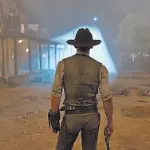Japanese director Ryūsuke Hamaguchi's latest film "Evil Does Not Exist" won the Silver Lion-Grand Jury Prize at the 80th Venice Film Festival. With this film, Hamaguchi accomplished a sweep of awards from the three major European film festivals.
"Evil Does Not Exist" has a slow narrative pace and minimal dialogue, standing out as a rare colorful one in a festival inundated with black-and-white films. Its uniqueness doesn't just lie in its external style of clarity and slowness but also in the sense of emptiness it conveys after abandoning an extreme and singular perspective (the denial of evil). This contrast with other films with clear-cut endings offers audiences a fresh perspective on cinema.

Let's delve into the restrained Japanese film's storyline:
Takumi, an honest and simple man, lives in a mountain village on the outskirts of Tokyo with his daughter, Hana. Takumi doesn't have a fixed job, but he is trusted by the other villagers, who often rely on him to solve their daily trivial problems. A Tokyo-based company plans to develop a luxurious camping program in the village, and two employees are sent to explain the project to the villagers. However, they face opposition from the villagers due to environmental concerns related to the location and safety issues associated with outdoor camping.
As Takumi is knowledgeable about everything in the wilderness, the village chief suggests that the employees consult with him. Takumi imparts some wisdom about nature and balance, but the employees return empty-handed. Frustrated, their boss decides to appoint the "idle" Takumi as a safety inspector and consultant.
The two employees make another trip to the village to persuade Takumi, and during the journey, they have conversations. In this interlude, the male employee expresses his desire to leave the city and live in the mountains, while the female employee discusses her future family plans. After failing to persuade Takumi again, the male employee expresses his wish to stay in the mountains and begs Takumi to lead them in experiencing life there.
Takumi agrees, but during their life experience, the two city-dwellers appear extremely clumsy: they can't even chop firewood properly, are frightened by the sound of gunshots, and get cut by plants in the forest. Along the way, the male employee asks Takumi if deer would harm people, to which Takumi replies that only a startled deer that has survived a gunshot wound might harm someone. Ultimately, due to the female employee's injury, they all return to Takumi's cabin for a brief rest.

While Takumi leads the two on their mountain adventure, his nature-loving daughter Hana roams between the forest and the factory in the village and suddenly disappears. Takumi goes to search for her, and the male employee volunteers to accompany him. Meanwhile, the female employee stays in Takumi's house and sees a photo of Takumi’s family of three, including his wife who never appears in this film, which makes her somewhat choked up. The entire village is mobilized to look for Hana.
The film's ending is enigmatic: Takumi and the male employee reach an open grassy field, where the light is dim, as if it's either just nightfall or dawn. Takumi seems to see Hana, who has already passed away, and he inexplicably strangles the male employee until he loses consciousness.
During the process of choking the male employee, a flashback to the moment before Hana's death is shown: she encounters a deer with a gunshot wound. After the male employee falls to the ground, Takumi carries his daughter's lifeless body into the mist. Suddenly, the male employee struggles to get up from the ground, trying to move into the mist as well. However, after stumbling a few steps, he falls again, just before reaching the mist. His bright red jacket stands out.
Then the film ends with scenes of the dimly lit forest and the sound of rapid breathing.
"Evil Does Not Exist" is filled with many details that are hard to describe with a few words in a story summary, and these details structurally contribute to the forming of a "foreshadowing-to-conclusion" (e.g., mentioning the startled deer leading to its involvement in Hana's death; water quality issues leading to the three of them eating noodles cooked with mountain spring water; discussion about family leading to the female employee staring at a family photo) closed loop.
Simultaneously, many of these details and symbols carry the weight of Japanese culture. Placed within the contemporary context of the film, these symbols become the most apparent evidence of the conflict between "city" and "nature," such as food culture (tap water vs. mountain spring water), firearms, and the concept of being "idle" versus a "jack of all trades." In these details, the audience not only senses the conflict between the city and the mountain village but also perceives the invasion and deconstruction of traditional customs by modernity.
As these details accumulate within the structure they form, the film culminates in an absurd eruption at the end. This kind of absurdity is a trademark of Ryūsuke Hamaguchi's style, and in his previous work "Drive My Car," based on a script by Haruki Murakami, the Kafkaesque absurdity is evident. In "Evil Does Not Exist," the scene where Takumi strangles the male employee, who has done nothing morally wrong but has become a natural victim, can also be seen as Hamaguchi's consistent arrangement in literary scripts.
The most interesting aspect of the entire film lies in how it questions the audience: how do we correlate the film's content with its title? Where does evil truly exist? In this slow-paced film, there is no expectation of a sudden and intense confrontation, so the strong sense of good and evil arising from such a confrontation cannot be discerned. Indeed, in the general understanding of the film's rhythm, we can identify evil in various aspects, such as the ecological damage caused by corporate real estate development in the village, the emotional attacks during the village meeting, and the capitalist who ignores ecological impacts and forces his subordinate to work. Even hunting deer with a rifle is regarded as evil. The film concludes with a male character being harmed, even "killed," which summarizes these prevalent forms of evil.
However, amid these evident acts of malice, why does evil not exist? In a conventional way of understanding, we could only find an explanation by looking into the final incident of the film—the frightened wounded deer causing the demise of the young girl Hana. From a natural perspective, this harm could be transformed into a natural axiom. Since Takumi is closely connected to nature, the audience easily builds a connection between Takumi losing his daughter and the wounded deer as a natural unity, thus completing the process of “de-evilization”.
However, within these man-made evil and “de-evilized” harm, the film addresses the dissolution of human morality. That is to say, under the standards of morality, people can differentiate between good and evil. In the film, although we encounter opposing symbols, such as city vs. mountain village, which allow us to sense “evil”, “good” is never directly mentioned. If the existence of “evil” is denied, then the “good” is also inevitably absent.
In this way, the film accomplishes a Baudelairean blurring and dismantling of the opposing concepts of good and evil. However, the film's ending is absurd, much like the moral nihilism that audiences could experience during the film. Takumi's final action—the ambiguous "evil act" (unethical but as natural as a wounded deer)—creates an undefined discomfort for the audience, and this is what makes the film a success.
"Evil Does Not Exist" offers audiences this kind of shifting parallax. As Slavoj Žižek wrote in "The Parallax View," " The common definition of parallax is: the apparent displacement of an object (the shift of its position against a background), caused by a change in observational position that provides a new line of sight. The philosophical twist to be added, of course, is that the observed difference is not simply ‘subjective,’ due to the fact that the same object which exists ‘out there’ is seen from two different stations, or points of view. It is rather that, as Hegel would have put it, subject and object are inherently ‘mediated’."
When we, as the audience, watch the actions taking place in the film, the reflection on 'evil' is generated exactly from the parallax, and the mediation between the audience and these actions. Thus, the enjoyment of watching the film reemerges. We cannot even regard actions of the actors in the film as purely “objective,” as the movie's plot is also a kind of fiction. However, the film itself exists as a reality. When we engage in watching and reflecting on our world through the film, we are simultaneously completing a “construction of the subject by reality.”

Therefore, within the parallax, we can likewise produce another interpretation of the film’s open ending, an interpretation that dissolves the evil: Hana's disappearance is precisely the most common 'vanishing act' in Japanese culture. In the end, Takumi walks into the mist with his daughter, and the male employee who was 'strangled' miraculously comes back to life and takes a few steps but fails to enter the mist. Could this also be understood as Takumi walking into the mist of death together with Hana, while the employee lives because he does not enter? The final gasping sound in the film may come from the surviving employee. After eliminating the moral wrongdoing causing death, evil does not exist.








Share your thoughts!
Be the first to start the conversation.